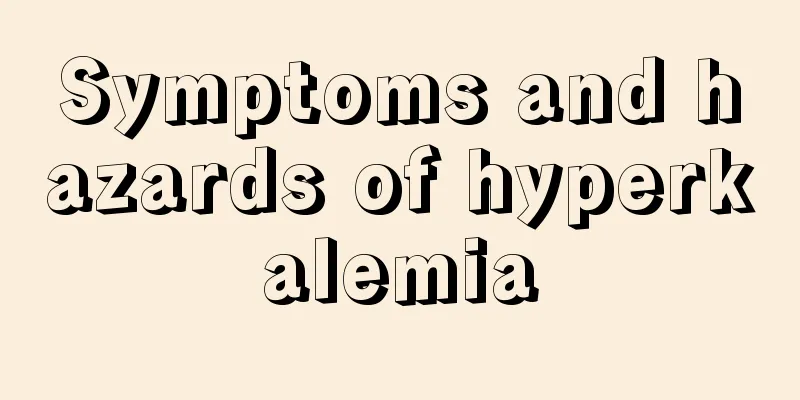Symptoms and hazards of hyperkalemia

|
As the name suggests, hyperkalemia means that the potassium content in the blood exceeds the normal standard. It is usually caused by a sudden and large intake of excessive potassium-containing substances, or other reasons. There are usually no special symptoms, so it is often misdiagnosed or missed, delaying the best treatment time. It is often discovered through electrocardiogram. Once hyperkalemia occurs, you should pay more attention to not being too tired, not doing heavy physical labor, and pay attention to the combination of work and rest. What are the symptoms and dangers of hyperkalemia? What are the dangers of hyperkalemia ? 1. Effect on cardiac excitability: Similar to the effect on skeletal muscle, in mild hyperkalemia, the [K+i/[K+e ratio decreases, the efflux of K+ from cells during resting period decreases, and the negative value of resting potential decreases, so the excitability of myocardium increases. The decrease in resting potential indicates that the cell membrane is in a partially depolarized state. Therefore, in phase 0 of the action potential, the rate of increase in the membrane potential is slower and the amplitude is smaller. This is because in the partially depolarized state, the fast sodium pore of the membrane is partially inactivated, so the rapid influx of sodium in phase 0 is reduced. When serum potassium rises significantly, myocardial excitability will decrease or even disappear due to the low resting potential, because most or all of the fast sodium pores are inactivated and the heartbeat may stop. 2. Impact on cardiac autonomy: In hyperkalemia, the potassium conductance on the membrane of fast-response autonomic cells in atrial conduction tissue and atrioventricular bundle-Purkinje fiber network increases. Therefore, after reaching the maximum repolarization potential, the outflow of potassium in the cell is faster than normal, while the inflow of sodium is relatively slower, thus slowing down automatic depolarization and reducing autonomy. 3. Effect on cardiac contractility: As mentioned above, the increase in extracellular K+ concentration in hyperkalemia inhibits the influx of Ca2+ during phase 2 of myocardial repolarization. Therefore, the Ca2+ concentration in myocardial cells decreases, the excitation-contraction coupling weakens, and the contractility decreases. 4. Impact on cardiac conductivity: As mentioned above, in hyperkalemia, the rate of rise of the membrane potential in phase 0 of the action potential slows down and the amplitude decreases, so the spread of excitement slows down and the conductivity decreases. Therefore, conduction delay or block may occur in the atrium, between the atrioventricular chambers or within the ventricles. The electrocardiogram shows that the P wave representing atrial depolarization is depressed, widened or disappeared, the PR interval representing atrioventricular conduction is prolonged, the R wave representing ventricular depolarization is reduced, and the QRS complex wave representing intraventricular conduction is widened. What are the early symptoms of hyperkalemia? 1. Neuromuscular symptoms In the early stages, there is often numbness in the limbs and around the mouth, extreme fatigue, muscle aches, pale, cold limbs. When the blood potassium concentration reaches 7mmol/L, the limbs become numb and limp, first the trunk, then the limbs, and finally the respiratory muscles are affected, causing suffocation. Central nervous system symptoms may include irritability or confusion. 2. Cardiovascular symptoms High potassium suppresses the myocardium and reduces myocardial tension, resulting in bradycardia and cardiac enlargement, weakened heart sounds, and prone to arrhythmias, but not heart failure. There are characteristic changes in the electrocardiogram, which are related to the degree of increase in blood potassium. 3. Other symptoms Hyperkalemia may cause nausea, vomiting, and abdominal pain due to increased release of acetylcholine. Due to the toxic effects of high potassium on muscles, it can cause quadriplegia and respiratory arrest. All hyperkalemias have varying degrees of azotemia and metabolic acidosis, the latter of which can aggravate hyperkalemia. |
<<: Dangers of taking a cold shower
>>: Symptoms and hazards of hyperlipidemia
Recommend
What are the dangers of having filamentous warts on the neck
The growth of filiform warts on the neck can be h...
Hip stretch
The hip joint is a very important joint in our bo...
What is the survival rate of late-stage nasopharyngeal carcinoma
The symptoms of nasopharyngeal cancer will have d...
How much does chemotherapy cost in the later stages of breast cancer
How much does chemotherapy cost for breast cancer...
Is fetal heart rate of 156 normal?
There are many factors that cause the fetal heart...
How to wash cherry tomatoes cleanly
Cherry tomatoes are also commonly known as small ...
Otitis media inheritance
Otitis media is a common disease in life. Otitis ...
Pain in the front thigh muscles
People will occasionally feel pain in the muscles...
What are the eyebrow shapes suitable for diamond-shaped faces?
Eyebrows play an important role on our face. When...
How to prevent bone cancer in daily life
Many diseases that make patients sad and desperat...
What happens if rice is soaked for a long time
We all know that after most people wash the rice,...
How much does ovarian cancer surgery cost
Everyone is familiar with ovarian cancer, because...
What to do if brain stem is blocked
The human brain is the most important part of the...
Peutz-Jeghers disease
I don’t know if you have heard of the disease cal...
Is it normal to have occasional insomnia?
Insomnia is becoming more and more common in our ...









